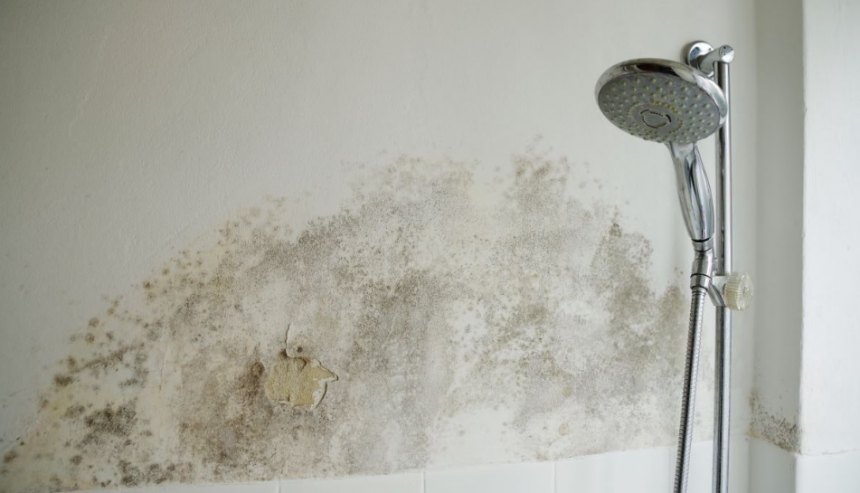How to Get Rid of Mold in your Shower and Bathroom
Are you tired of battling that stubborn, unsightly mold in your shower? You’re not alone. Mold in the bathroom, especially in the shower, is a common nuisance that many homeowners face. Not only does it look unattractive, but it can also pose potential health risks and damage to your property if left untreated.
But fear not! In this comprehensive guide, we’ll explore effective strategies and techniques to banish mold from your shower for good. From understanding the root causes of mold growth to practical tips for prevention and removal, we’ve got you covered. Say goodbye to mold and hello to a clean, healthy shower space. Let’s dive in and reclaim your bathroom from the clutches of mold!
Is black mold in shower dangerous?
Yes, black mold in the shower can indeed be dangerous. While not all black molds are toxic, some types, such as Stachybotrys chartarum, commonly known as “black mold,” can produce mycotoxins that may cause health issues, especially when they are present in large quantities or for prolonged periods.
Exposure to black mold spores can lead to various health problems, including respiratory issues such as coughing and wheezing, nasal congestion, throat irritation, skin irritation, and allergic reactions. Individuals with asthma, allergies, or weakened immune systems are particularly susceptible to the effects of black mold exposure.
Moreover, black mold thrives in moist environments, making the shower an ideal breeding ground. Its presence not only poses health risks but can also cause structural damage to your home if left untreated.
Therefore, it’s crucial to address black mold promptly and take steps to prevent its recurrence. Regular cleaning and maintenance, ensuring proper ventilation, and promptly fixing any leaks or water damage can help mitigate the risk of black mold growth in your shower and maintain a safe and healthy environment for you and your family.
For Mold Removal Service in New Jersey, Call (877) 750-7876
Why Does Mold Grow in Bathrooms?
Mold growth in bathrooms is a common occurrence due to several factors, primarily revolving around moisture and organic matter. Bathrooms provide an ideal environment for mold to thrive because they are often warm, humid, and contain various organic materials that mold can feed on. Here are some key reasons why mold tends to grow in bathrooms:
High Humidity: Bathrooms are typically one of the most humid areas in a home due to activities like showering, bathing, and washing. Excess moisture in the air creates a conducive environment for mold growth, especially in poorly ventilated bathrooms where humidity levels can remain elevated for extended periods.
Poor Ventilation: Inadequate ventilation exacerbates humidity problems by trapping moisture in the bathroom. Without proper airflow, damp air lingers, allowing mold spores to settle on surfaces and proliferate. Areas like shower stalls, behind toilets, and around sinks are particularly vulnerable to mold growth in poorly ventilated bathrooms.
Leaky Fixtures and Pipes: Dripping faucets, leaky pipes, and poorly sealed fixtures contribute to moisture accumulation in bathrooms. Even minor leaks can lead to hidden pockets of moisture behind walls or under flooring, providing the perfect conditions for mold growth.
Organic Materials: Mold requires organic matter to grow, and bathrooms offer plenty of suitable surfaces for colonization. Grout, caulking, drywall, wallpaper, and even soap scum can serve as food sources for mold when combined with moisture.
Lack of Regular Cleaning: Neglected bathrooms accumulate dirt, soap residue, and other organic debris over time, providing additional nutrients for mold. Infrequent cleaning allows mold spores to settle and establish colonies, leading to visible growth over time.
How to Get Rid of Mold in your Shower
Getting rid of mold in your shower requires a combination of thorough cleaning and preventative measures to keep it from coming back. Here’s a step-by-step guide to effectively remove mold from your shower:
Safety Precautions:
Before you begin, ensure proper ventilation by opening windows or running exhaust fans.
Wear gloves, a mask, and protective eyewear to prevent exposure to mold spores and cleaning chemicals.
Preparation:
Remove any personal items, such as shampoo bottles, soap dishes, and bath mats, from the shower area.
Mix a solution of water and mild detergent or a commercial mold and mildew cleaner according to the manufacturer’s instructions.
Scrubbing:
Use a stiff-bristled brush or a sponge to scrub the moldy areas thoroughly.
Pay special attention to grout lines, caulking, tile seams, and other porous surfaces where mold tends to thrive.
For stubborn mold stains, you may need to use a mixture of baking soda and water or a bleach solution (1 part bleach to 10 parts water) to help break down the mold.
Rinsing:
Rinse the cleaned areas with water to remove any residual cleaner or loosened mold particles.
Use a clean cloth or sponge to wipe down the surfaces and remove excess moisture.
Drying:
Allow the shower surfaces to air dry completely. Use a towel to pat dry any remaining moisture, especially in hard-to-reach areas.
Consider using a fan or opening windows to expedite the drying process and prevent moisture buildup.
Preventative Measures:
Once the shower is clean and dry, take steps to prevent mold from returning.
Apply a mold-resistant sealant to grout lines and caulking to create a barrier against moisture and mold growth.
Use a squeegee or towel to wipe down wet surfaces after showering to minimize moisture buildup.
Clean the shower regularly using a mildew-resistant cleaner to prevent mold from recurring.
Monitor and Maintain:
Regularly inspect your shower for signs of mold growth, such as black spots or musty odors.
Address any leaks, water damage, or ventilation issues promptly to prevent mold from taking hold again.
Call Us for Expert Mold Removal in New Jersey – (877) 750-7876
Living in a mold-infested home can be a nightmare. Fortunately, PuroClean Emergency Recovery Services New Jersey is here to help. With years of experience and a team of skilled professionals, we have the expertise you need to eliminate and prevent mold in your home and give you a fresh start. From identifying the cause to implementing effective remediation strategies, our team has the knowledge and tools to make your home mold-free. Don’t put off your mold concerns any longer. Get in touch with us today at (877) 750-7876 and start enjoying a cleaner, fresher, and healthier living space!
How To Prevent Future Mold Growth in the Bathroom
Preventing future mold growth in the bathroom requires a combination of proactive measures to control moisture levels, improve ventilation, and maintain cleanliness. Here’s a comprehensive guide to help you keep mold at bay:
Improve Ventilation:
Use exhaust fans or open windows during and after bathing to reduce humidity levels.
Ensure that exhaust fans are properly sized for the bathroom and vented to the outside, not just into the attic.
Run exhaust fans for at least 20 minutes after showering or bathing to remove excess moisture from the air.
Fix Leaks and Sealants:
Regularly inspect faucets, pipes, and fixtures for leaks and repair them promptly.
Check caulking and grout around sinks, tubs, and showers for signs of deterioration and reseal as needed to prevent water infiltration.
Control Moisture:
Use a squeegee or towel to wipe down wet surfaces after showering to reduce moisture buildup.
Install a waterproof shower curtain liner and keep it closed to prevent water from splashing onto surrounding surfaces.
Consider using moisture-absorbing products like silica gel packets or desiccants in cabinets or closets to help control humidity levels.
Promote Air Circulation:
Leave bathroom doors and shower curtains open after use to allow air circulation and promote drying.
Keep closet doors ajar to allow airflow and prevent moisture buildup in enclosed spaces.
Clean Regularly:
Clean bathroom surfaces, including walls, floors, and fixtures, regularly using a mildew-resistant cleaner or a solution of water and white vinegar.
Pay attention to areas prone to mold growth, such as grout lines, caulking, and tile seams, and scrub them thoroughly to remove any buildup.
Launder shower curtains, bath mats, and towels regularly to prevent mold and mildew from developing on fabric surfaces.
Getting rid of mold in shower walls or shower tiles
Prepare the Area:
- Remove any personal items from the shower area.
- Ventilate the space by opening windows or running exhaust fans.
Mix Cleaning Solution:
Prepare a solution of warm water and mild detergent or a commercial mold and mildew cleaner according to the product instructions.
Scrubbing:
- Dip a stiff-bristled brush or sponge into the cleaning solution.
- Scrub the moldy areas on the shower walls thoroughly, paying close attention to grout lines, corners, and any other areas where mold is present.
- For stubborn mold stains, use a mixture of baking soda and water or a bleach solution (1 part bleach to 10 parts water) to help break down the mold.
Rinsing:
Rinse the cleaned areas with water to remove any residual cleaner or loosened mold particles.
Use a clean cloth or sponge to wipe down the walls and remove excess moisture.
Drying:
Allow the shower walls to air dry completely. Use a towel to pat dry any remaining moisture.
Preventative Measures:
- Apply a mold-resistant sealant to grout lines and caulking to create a barrier against moisture and mold growth.
- Use a squeegee or towel to wipe down wet walls after showering to minimize moisture buildup.
- Clean the shower walls regularly using a mildew-resistant cleaner to prevent mold from recurring.
What is the best cleaner for mold in shower?
The best cleaner for mold in your shower depends on your preferences, the severity of the mold problem, and any sensitivities you may have to certain ingredients. It’s essential to choose a cleaner that effectively kills mold while being safe for you and your family. Always follow safety precautions and test any cleaner on a small, inconspicuous area before widespread use.




 PuroClean Emergency Recovery Services
PuroClean Emergency Recovery Services